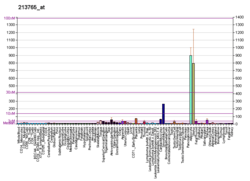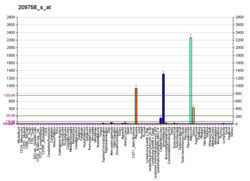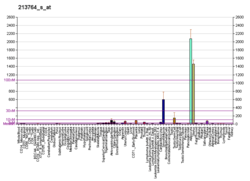MFAP5
Microfibrillar-associated protein 5 is a protein that in humans is encoded by the MFAP5 gene.[5][6][7]
This gene encodes a 25-kD microfibril-associated glycoprotein which is rich in serine and threonine residues. It lacks a hydrophobic carboxyl terminus and proline-, glutamine-, and tyrosine-rich regions, which are characteristics of a related 31-kDa microfibril-associated glycoprotein (MFAP2). The close similarity between these two proteins is confined to a central region of 60 aa where precise alignment of 7 cysteine residues occurs. The structural differences suggest that this encoded protein has some functions that are distinct from those of MFAP2.[7]
References
- GRCh38: Ensembl release 89: ENSG00000197614 - Ensembl, May 2017
- GRCm38: Ensembl release 89: ENSMUSG00000030116 - Ensembl, May 2017
- "Human PubMed Reference:". National Center for Biotechnology Information, U.S. National Library of Medicine.
- "Mouse PubMed Reference:". National Center for Biotechnology Information, U.S. National Library of Medicine.
- Hatzinikolas G, Gibson MA (Dec 1998). "The exon structure of the human MAGP-2 gene. Similarity with the MAGP-1 gene is confined to two exons encoding a cysteine-rich region". J Biol Chem. 273 (45): 29309–14. doi:10.1074/jbc.273.45.29309. PMID 9792630.
- Gibson MA, Hatzinikolas G, Kumaratilake JS, Sandberg LB, Nicholl JK, Sutherland GR, Cleary EG (Feb 1996). "Further characterization of proteins associated with elastic fiber microfibrils including the molecular cloning of MAGP-2 (MP25)". J Biol Chem. 271 (2): 1096–103. doi:10.1074/jbc.271.2.1096. PMID 8557636.
- "Entrez Gene: MFAP5 microfibrillar associated protein 5".
Further reading
- Miyamoto A, Lau R, Hein PW, et al. (2006). "Microfibrillar proteins MAGP-1 and MAGP-2 induce Notch1 extracellular domain dissociation and receptor activation". J. Biol. Chem. 281 (15): 10089–97. doi:10.1074/jbc.M600298200. PMID 16492672.
- Gerhard DS, Wagner L, Feingold EA, et al. (2004). "The status, quality, and expansion of the NIH full-length cDNA project: the Mammalian Gene Collection (MGC)". Genome Res. 14 (10B): 2121–7. doi:10.1101/gr.2596504. PMC 528928. PMID 15489334.
- Imabayashi H, Mori T, Gojo S, et al. (2003). "Redifferentiation of dedifferentiated chondrocytes and chondrogenesis of human bone marrow stromal cells via chondrosphere formation with expression profiling by large-scale cDNA analysis". Exp. Cell Res. 288 (1): 35–50. doi:10.1016/S0014-4827(03)00130-7. PMID 12878157.
- Strausberg RL, Feingold EA, Grouse LH, et al. (2003). "Generation and initial analysis of more than 15,000 full-length human and mouse cDNA sequences". Proc. Natl. Acad. Sci. U.S.A. 99 (26): 16899–903. doi:10.1073/pnas.242603899. PMC 139241. PMID 12477932.
- Penner AS, Rock MJ, Kielty CM, Shipley JM (2002). "Microfibril-associated glycoprotein-2 interacts with fibrillin-1 and fibrillin-2 suggesting a role for MAGP-2 in elastic fiber assembly". J. Biol. Chem. 277 (38): 35044–9. doi:10.1074/jbc.M206363200. PMID 12122015.
- Bonaldo MF, Lennon G, Soares MB (1997). "Normalization and subtraction: two approaches to facilitate gene discovery". Genome Res. 6 (9): 791–806. doi:10.1101/gr.6.9.791. PMID 8889548.
This article is issued from Wikipedia. The text is licensed under Creative Commons - Attribution - Sharealike. Additional terms may apply for the media files.






